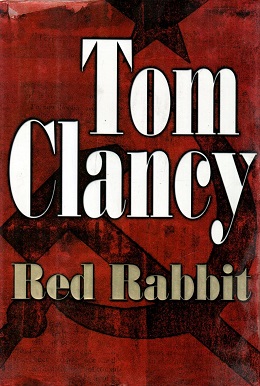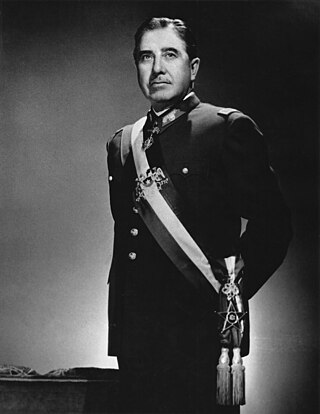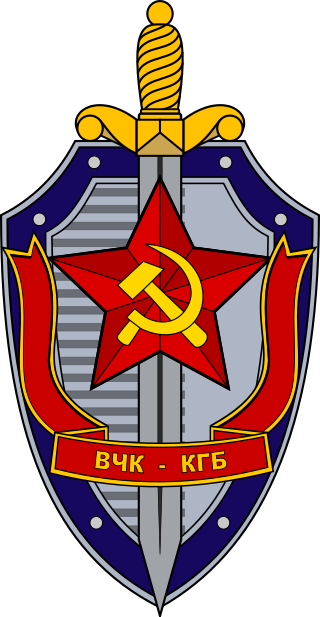Related Research Articles

Yuri Vladimirovich Andropov was a Soviet politician who was the sixth leader of the Soviet Union and the fourth General Secretary of the Communist Party of the Soviet Union, taking office in late 1982 and serving until his death in 1984.

Vladimiro Lenin Ilich Montesinos Torres is a Peruvian former intelligence officer and lawyer, most notorious for his role as the head of Peru's National Intelligence Service (SIN) during the presidency of Alberto Fujimori. Montesinos was widely regarded as the power behind the throne, often regarded as the true authority in the government, supported by the Peruvian Armed Forces.

Red Rabbit is a spy thriller novel, written by Tom Clancy and released on August 5, 2002. The plot occurs a few months after the events of Patriot Games (1987), and incorporates the 1981 assassination attempt on Pope John Paul II. Main character Jack Ryan, now an analyst for the Central Intelligence Agency, takes part in the extraction of a Soviet defector who knows of a KGB plot to kill the pontiff. The book debuted at number one on The New York Times Best Seller list.

Vasili Nikitich Mitrokhin was an archivist for the Soviet Union's foreign intelligence service, the First Chief Directorate of the KGB, who defected to the United Kingdom in 1992. Mitrokhin first offered his material to the US' Central Intelligence Agency (CIA) in Latvia but they rejected it as possible fakes. After that, he resorted to the UK's MI6 which arranged his defection from Russia. These notes became known as the Mitrokhin Archives.

Alexander Mikhailovich Orlov, was a colonel in the Soviet secret police and NKVD Rezident in the Second Spanish Republic. In 1938, Orlov refused to return to the Soviet Union due to fears of execution, and instead fled with his family to the United States. He is mostly known for secretly transporting the entire Spanish gold reserves to the USSR in exchange for military aid for Spanish Republic and for his book, The Secret History of Stalin's Crimes.

Active measures is a term used to describe political warfare conducted by the Soviet Union and the Russian Federation. The term, which dates back to the 1920s, includes operations such as espionage, propaganda, sabotage and assassination, based on foreign policy objectives of the Soviet and Russian governments. Active measures have continued to be used by the administration of Vladimir Putin.

The First Main Directorateof the Committee for State Security under the USSR council of ministers was the organization responsible for foreign operations and intelligence activities by providing for the training and management of covert agents, intelligence collection administration, and the acquisition of foreign and domestic political, scientific and technical intelligence for the Soviet Union.

Philip Burnett Franklin Agee was a Central Intelligence Agency (CIA) case officer and writer of the 1975 book, Inside the Company: CIA Diary, detailing his experiences in the CIA. Agee joined the CIA in 1957, and over the following decade had postings in Washington, D.C., Ecuador, Uruguay and Mexico. After resigning from the Agency in 1968, he became a leading opponent of CIA practices. A co-founder of the CounterSpy and CovertAction series of periodicals, he died in Cuba in January 2008.
The Intelligence Directorate, commonly known as G2 and, until 1989, named Dirección General de Inteligencia (DGI), is the main state intelligence agency of the government of Cuba. The DI was founded in late 1961 by Cuba's Ministry of the Interior shortly after the Cuban Revolution. The DI is responsible for all foreign intelligence collection and comprises six divisions divided into two categories, which are the Operational Divisions and the Support Divisions.
As early as the 1920s, the Soviet Union, through its GRU, OGPU, NKVD, and KGB intelligence agencies, used Russian and foreign-born nationals, as well as Communists of American origin, to perform espionage activities in the United States, forming various spy rings. Particularly during the 1940s, some of these espionage networks had contact with various U.S. government agencies. These Soviet espionage networks illegally transmitted confidential information to Moscow, such as information on the development of the atomic bomb. Soviet spies also participated in propaganda and disinformation operations, known as active measures, and attempted to sabotage diplomatic relationships between the U.S. and its allies.

Iosif Romualdovich Grigulevich was a Soviet secret police (NKVD) operative active between 1937 and 1953, when he played a role in assassination plots against Communist and Bolshevik individuals who were not loyal to Joseph Stalin. This included the murders of claimed and actual Trotskyists during the Spanish Civil War including Andreu Nin Pérez, and an initial, failed assassination attempt against Leon Trotsky in Mexico.

Operation TOUCAN was a KGB/DGI public relations and disinformation campaign directed at the military government of Chile led by Augusto Pinochet, particularly the Dirección de Inteligencia Nacional (DINA). The plot's twofold task was to organize sympathetic human rights activists to pressure the United Nations and generate negative press for the Pinochet regime. According to former KGB officer Vasili Mitrokhin, the plot was originally conceived by Yuri Vladimirovich Andropov. It was approved on August 10, 1976.
Operation RYAN was a Cold War military intelligence program run by the Soviet Union in the early 1980s, when they believed the United States was planning for an imminent first strike attack. The name is an acronym for Raketno-Yadernoe Napadenie. The purpose of the operation was to collect intelligence on potential contingency plans of the Reagan administration to launch a nuclear first strike against the Soviet Union. The program was initiated in May 1981 by Yuri Andropov, then chairman of the KGB.
The Mitrokhin Archive refers to a collection of handwritten notes about secret KGB operations spanning the period between the 1930s and 1980s made by KGB archivist Vasili Mitrokhin which he shared with the British intelligence in the early 1990s. Mitrokhin, who had worked at KGB headquarters in Moscow from 1956 to 1985, first offered his material to the US' Central Intelligence Agency (CIA) in Latvia, but they rejected it as possible fakes. After that, he turned to the UK's MI6, which arranged his defection from Russia.
The National Intelligence Service was an intelligence agency of the Government of Peru that existed from 1960 to 2001. It was headquartered at the Quiñones Building, the headquarters of the country's Defence Ministry.
The Mitrokhin Commission was an Italian parliamentary commission set up in 2002 to investigate alleged KGB ties of some Italian politicians. Set up by the Italian Parliament, then led by Silvio Berlusconi's centre-right coalition, the House of Freedoms, and presided by Paolo Guzzanti, its focus was on alleged KGB ties to opposition figures in Italian politics, basing itself on the Mitrokhin Archive, which was controversial and viewed with scepticism, and various other sources including the consultant Mario Scaramella. The Mitrokhin Commission alleged, among other things, that Romano Prodi, former centre-left Prime Minister of Italy and President of the European Commission from 1999 to 2004, was the "KGB's man in Italy".

The active reserve of the KGB are members of the organization who work undercover "either pretending to assume various jobs or using as cover professions in which they are actually trained". Active reserve KGB officers typically occupied such positions as deputy directors of scientific research or deans responsible for foreign relations in academic institutions of the Soviet Union, although these people were not scientists. Other officers were trained for certain civilian jobs, usually translators, journalists, telephone engineers, or doormen in hotels that served foreigners.

The Committee for State Security, abbreviated as KGB was the main security agency of the Soviet Union from 1954 to 1991. It was the direct successor of preceding Soviet secret police agencies including the Cheka, OGPU, and NKVD. Attached to the Council of Ministers, it was the chief government agency of "union-republican jurisdiction", carrying out internal security, foreign intelligence, counter-intelligence and secret police functions. Similar agencies operated in each of the republics of the Soviet Union aside from the Russian SFSR, where the KGB was headquartered, with many associated ministries, state committees and state commissions.
Russian espionage in the United States has occurred since at least the Cold War, and likely well before. According to the United States government, by 2007 it had reached Cold War levels.
Aleksander Grigoryevich Kopatzky was a Soviet double agent who was belatedly uncovered in 1965 by possible KGB "mole" Bruce Solie in CIA's mole-hunting Office of Security five years after he had retired from the CIA. Kopatzky used the names Aleksandr Navratilov and Calvus, and, in the U.S., Igor Orlov. His Soviet codenames were Erwin, Herbert and Richard.
References
- 1 2 3 4 5 6 7 8 9 10 Andrew, Christopher; Mitrokhin, Vasili (2018). The Mitrokhin Archive II: The KGB in the World. Penguin Books Limited. pp. 79–81. ISBN 9780141977980.
- ↑ Romanchenko, Igor (2023-01-17). "Perú-Rusia: 160 años de amistad". El Peruano .
- ↑ "The report by the agent "Koral" about the operational situation in one of the seaports in Peru" (PDF). KGB Documents. Archived from the original (PDF) on 2024-01-23.